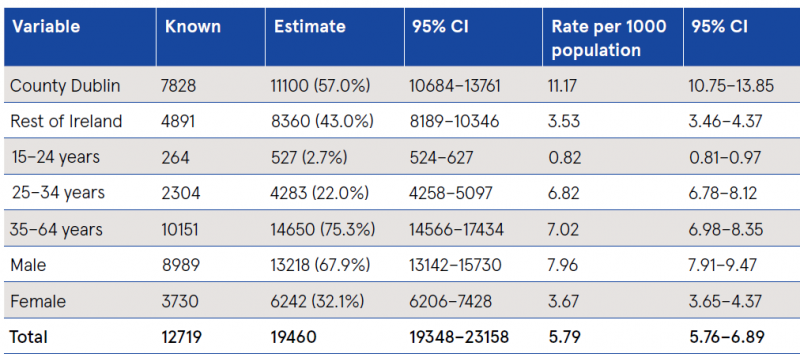Hanrahan, Michael T, Millar, Seán R  ORCID: https://orcid.org/0000-0003-4453-8446, Mongan, Deirdre
ORCID: https://orcid.org/0000-0003-4453-8446, Mongan, Deirdre  ORCID: https://orcid.org/0000-0003-3616-4253, Lyons, Suzi
ORCID: https://orcid.org/0000-0003-3616-4253, Lyons, Suzi  ORCID: https://orcid.org/0000-0002-4635-6673 and Galvin, Brian
(2025)
Prevalence of problematic opioid use in Ireland, 2020–2022.
Dublin:
Health Research Board.
ORCID: https://orcid.org/0000-0002-4635-6673 and Galvin, Brian
(2025)
Prevalence of problematic opioid use in Ireland, 2020–2022.
Dublin:
Health Research Board.
| Preview | Title | Contact |
|---|---|---|
|
PDF (Prevalence of problematic opioid use in Ireland, 2020–2022)
- Published Version
980kB |
Overview of the study: This report presents the findings from a study that aimed to estimate the prevalence of problematic opioid use in Ireland from 2020 to 2022 utilising a four-source capture-recapture methodology. The analysis incorporated three data sources from opioid substitution treatment (OST) records obtained from the Central Treatment List (CTL), which includes clinics, general practitioners (GPs), and prisons. The fourth data source was provided by the Probation Service.
Key findings: Table 1 presents a summary of the study’s main results, stratified by County Dublin versus the rest of Ireland, as well as by age group and sex. In 2022, it was estimated that there were approximately 19,460 individuals in Ireland with problematic opioid use (95% confidence interval (CI): 19,348–23,158), which equates to a prevalence rate of 5.79 per 1,000 population (95% CI: 5.76–6.89). A significant majority of these individuals were male (67.9%), and more than twothirds (75.3%) fell within the older age group of 35–64-year-olds. There were an estimated 11,100 problematic opioid users (95% CI: 10,684–13,761) in County Dublin in 2022, reflecting a rate more than three times higher than that in the rest of Ireland (11.17 per 1,000 population (95% CI: 10.75–13.85) compared with 3.53 per 1,000 population (95% CI: 3.46–4.37)).
Table 1: Total estimated number of problematic opioid users, by location, age group, and sex (2022)

Additional insights: This report also includes estimates for prevalence rates across Regional Health Areas (RHAs), Community Healthcare Organisation (CHO) areas, Regional Drug and Alcohol Task Force (RDATF) areas, and selected cities. Data on the prevalence of problematic opioid use for the years 2020 and 2021 are also presented to illustrate trends over time. Although there was a slight decrease in the overall number of problematic opioid users between 2020 and 2022, this decrease was not statistically significant. Notably, however, the prevalence of problematic opioid use among 15–24-year-olds appears to be decreasing.
A Substance use and dependence > Prevalence > Problem substance use
A Substance use and dependence > Prevalence > Substance use behaviour
A Substance use and dependence > Substance related societal (social) problems / harms
B Substances > Opioids (opiates)
G Health and disease > Substance use disorder (addiction) > Drug use disorder
T Demographic characteristics > Gender / sex differences
VA Geographic area > Europe > Ireland
VA Geographic area > Europe > Ireland > County / regional data
Repository Staff Only: item control page